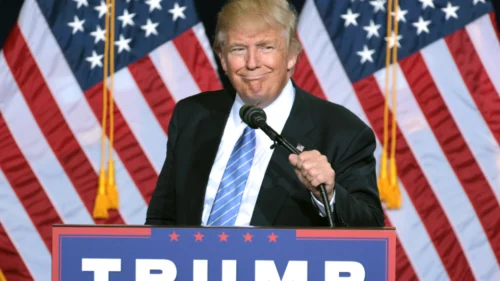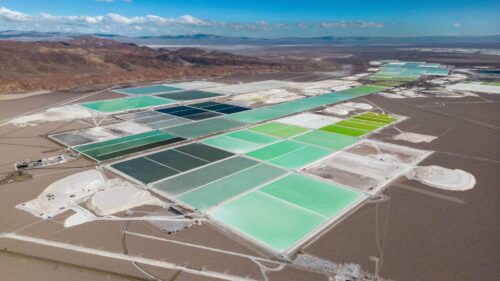In 1788, a year before the United States Constitution became the law of the land, James Madison wrote in the Federalist Papers that the powers delegated to the federal government by the proposed Constitution are “few and defined,” while those remaining in the hands of state governments are “numerous and indefinite.” US President Donald Trump’s administration is testing this fundamental American principle of states’ rights on several fronts, and the environment is one of them.
Since beginning his second term, Trump has reversed many climate regulations and clean-energy incentives, which has heavily shifted the nation’s energy policy to fossil fuel production. He has withdrawn the US from the Paris Agreement for the second time, disbanded the Interagency Working Group on the Social Cost of Greenhouse Gases and dismantled the Environmental Protection Agency (EPA)’s environmental justice office. These moves will have serious consequences for the environment and public health.
“What this administration is doing is endangering all of our lives—ours, our children, our grandchildren,” Christine Todd Whitman, who served as President George W. Bush’s EPA chief, said in March 2025 about the proposed rollback of more than 30 environmental rules. “We all deserve to have clean air to breathe and clean water to drink. If there’s an endangerment finding to be found anywhere, it should be found on this administration because what they’re doing is so contrary to what the Environmental Protection Agency is about.”
Legal scholars have expressed concerns that several of the Trump administration’s actions may challenge the constitutional principle of states’ rights. A bipartisan group of over 950 law professors and teachers have signed a letter criticizing the administration’s executive orders as illegal and unconstitutional. “We believe we are in a constitutional crisis,” the signatories wrote.
Additionally, experts from UC Law San Francisco have discussed the legal limits of the administration’s sweeping executive order. They have emphasized that while presidents can issue orders within their delegated powers, they cannot override laws or dictate state and local government actions. Radhika Rao, a professor at UC Law San Francisco, noted the administration’s “coercive use of federal power to intrude into areas traditionally governed by state and local law.”
Key strategies for states
As the federal government rolls back environmental protections and loosens regulations on polluting industries, it is more crucial than ever for US states to protect the natural ecosystem and public health. They can do this by leveraging their legal authority, promoting local environmental policies and collaborating with other states to form strong coalitions.
“The way that our federalism works is [that] states have quite a lot of power to take action to both reduce carbon pollution and to protect residents from climate impacts,” Wade Crowfoot, head of California’s Natural Resources Agency, told Mother Jones in January 2025. “So regardless of who is president, states like California have been driving forward and will continue to drive forward.”
Here are some key strategies that states can employ to maintain control:
1. Enact strong state-level environmental regulations: States can create and enforce environmental laws that exceed federal standards. One notable example is the state of California, which has stringent air and water quality regulations that go beyond federal requirements. For instance, the state can establish its own pesticide use limits and waste disposal regulations to protect natural resources.
In addition, California can seek waivers from the EPA to set its own vehicle emission standards through the Clean Air Act of 1967. In 2022, the state adopted the Advanced Clean Cars II regulation, which was implemented to discontinue the sale of new gas-powered cars by 2035. The EPA approved a waiver for the program in December 2024.
Regardless, Trump has threatened to block California’s clean air initiatives. Whether he will succeed is questionable, as any reversal would likely face legal challenges. In fact, during his first term, Trump tried to dismantle several of California’s environmental laws. However, when contested in court, his administration lost 83% of its cases.
States can also strengthen their authority to protect resources against federal actions by incorporating “Green Amendments” or “Environmental Rights Amendments” into their constitutions. These amendments grant citizens a constitutional right to a clean and healthy environment. As of 2025, three states have such amendments in their constitutions: Pennsylvania, Montana and New York.
2. Utilize state sovereignty and the Tenth Amendment: The Tenth Amendment grants US states powers not delegated to the federal government. States can use this to argue that specific federal actions infringing on local environmental protections are unconstitutional. When federal agencies attempt to supersede state regulations, states can assert their rights under the Tenth Amendment and file lawsuits to block federal overreach, claiming federal actions violate state sovereignty or overstep the limits of federal authority.
In September 2017, the EPA’s Office of Enforcement and Compliance Assurance published a guidance document outlining the collaborative power distribution between the federal government and the states, known as cooperative federalism. It stated:
“As has long been the case, the overwhelming majority of EPA’s enforcement actions are taken in programs that are not delegable to the states or in states that have not sought authorization to implement a delegable program. In authorized states, EPA and states share enforcement responsibility with primary enforcement responsibility residing with the states, which often join with EPA in bringing cases. EPA generally takes the enforcement lead in authorized states only: 1) at the request of the state; 2) when the state is not well positioned to bring an action (e.g., federal and state facilities or in actions involving facilities in multiple states); 3) when the state ‘do[es] not provide the resources necessary to meet national regulatory minimum standards or ha[s] a documented history of failure to make progress toward meeting national standards;’ or 4) when EPA has a unique role, including emergency situations and national enforcement priority areas, and actions addressing violations across multiple state jurisdictions.”
3. Challenge federal decisions in court: States can file lawsuits against federal agencies if they believe actions, such as approving environmentally harmful projects or rolling back regulations, threaten local ecosystems. For example, multiple states have sued the federal government over detrimental changes it made to the Clean Water Act and the Endangered Species Act. These lawsuits can slow down or prevent federal initiatives that states view as exploitative, preserving local environments and resources.
For instance, in September 2019, a total of 17 US states — led by California, Massachusetts, and Maryland — sued the Trump administration over harmful changes it had made to the Endangered Species Act. The new rules ended protections for animals newly listed as threatened species and curtailed the preservation of critical habitat. In 2022, US District Judge Jon S. Tigar eliminated the rules, reinstating protections for hundreds of species.
4. Form state coalitions and interstate compacts: States can form coalitions to present a unified stance against federal policies that may harm the environment. They can also negotiate interstate compacts, which are agreements between two or more states to jointly address shared concerns, such as transportation, public safety and natural resources like rivers or forests. These agreements can set regional standards that limit federal intervention in these areas.
Here are some notable examples:
- The Port Authority of New York and New Jersey (PANYNJ) (1921): This joint venture between New York and New Jersey enables both states to manage and develop transportation infrastructure, including airports, bridges, tunnels and seaports, in the New York-Newark-Jersey City metropolitan area. The PANYNJ has adopted a series of environmental projects to reduce greenhouse gas emissions, including the Net Zero Roadmap, an extensive plan to reach net-zero carbon emissions by 2050.
- The Colorado River Compact (1922): This compact includes seven western states — Arizona, California, Colorado, Nevada, New Mexico, Utah and Wyoming — and allocates water rights from the Colorado River. It provides a framework for managing and sharing this critical resource for agriculture, drinking water and energy.
- The Regional Greenhouse Gas Initiative (RGGI) (2009): The RGGI is a cooperative effort among northeastern and mid-Atlantic states to reduce greenhouse gas emissions. The states involved are Connecticut, Delaware, Maine, Maryland, Massachusetts, New Hampshire, New Jersey, New York, Pennsylvania, Rhode Island and Vermont. Participating states have a cap-and-trade program that limits carbon emissions from power plants and encourages cleaner energy production.
- The Emergency Management Assistance Compact (EMAC) (1996): EMAC is a national compact that enables states to assist one another during natural or man-made disasters. States can send personnel, equipment and other resources to other states in times of crisis. This compact has been instrumental in coordinating responses to disasters like hurricanes and wildfires by providing legal and logistical frameworks for mutual aid.
These examples underscore the critical role of interstate compacts in environmental protection, public health, disaster management and economic regulation. By leveraging these agreements, states can effectively coordinate policies, safeguard resources and reinforce regional stability, security and sustainability.
5. Leverage public and local support: States can rally public opinion and involve local stakeholders — including tribal governments, environmental groups and local businesses — to oppose federal actions that might damage the environment. Public support can pressure the federal government to reconsider environmentally harmful policies.
Engaging communities can also bolster state-led environmental programs, as residents who are directly affected by potential exploitation will be more motivated to support protective measures. In fact, in 2024, several states voted to protect a number of state-led climate initiatives. Minnesota residents voted to extend the Environmental and Natural Resources Trust fund, which will preserve air, land, water and wildlife through 2050. Washington state residents voted to keep the state’s Climate Commitment Act and cap-and-invest program. Wisconsin residents rejected an amendment that would have restricted the governor’s power to spend federal emergency funds, including for environmental disaster relief.
Democratic states challenge federal environmental policies
Democratic governors and senators have actively utilized state legal authority to counteract federal environmental protection rollbacks. In response to Trump’s policies, California Governor Gavin Newsom declared a state of emergency to expedite forest management, aiming to reduce wildfire risks and challenge federal criticisms of state environmental regulations.
Additionally, Newsom convened a special legislative session to bolster the state’s Department of Justice funding, preparing for legal challenges against anticipated federal policies that could adversely affect environmental protections.
Similarly, Democratic senators have opposed attempts to weaken environmental regulations, such as mobilizing against a bill that would have loosened Clean Air Act mandates. This emphasized the importance of maintaining stringent air quality standards.
State legislators in Virginia, led by Democrats, voted against bills that would have removed the state’s adherence to California’s vehicle emissions standards, underscoring their commitment to robust environmental policies. Together, these actions reflect a concerted effort by Democratic state leaders to leverage legal mechanisms in defense of environmental protections.
By implementing robust local policies, capitalizing on their constitutional rights and fostering multi-state cooperation, US states can establish substantial barriers against federal actions that threaten their environmental priorities. State governors and legislators must act quickly. Considering the fact that 2024 was the warmest year on record globally and the first calendar year in which the average global temperature exceeded 1.5° C above pre-industrial levels, there is precious little time to waste.
[Earth | Food | Life, a project of the Independent Media Institute, produced this piece.]
[Lee Thompson-Kolar edited this piece.]
The views expressed in this article are the author’s own and do not necessarily reflect Fair Observer’s editorial policy.
Support Fair Observer
We rely on your support for our independence, diversity and quality.
For more than 10 years, Fair Observer has been free, fair and independent. No billionaire owns us, no advertisers control us. We are a reader-supported nonprofit. Unlike many other publications, we keep our content free for readers regardless of where they live or whether they can afford to pay. We have no paywalls and no ads.
In the post-truth era of fake news, echo chambers and filter bubbles, we publish a plurality of perspectives from around the world. Anyone can publish with us, but everyone goes through a rigorous editorial process. So, you get fact-checked, well-reasoned content instead of noise.
We publish 2,500+ voices from 90+ countries. We also conduct education and training programs
on subjects ranging from digital media and journalism to writing and critical thinking. This
doesn’t come cheap. Servers, editors, trainers and web developers cost
money.
Please consider supporting us on a regular basis as a recurring donor or a
sustaining member.
Will you support FO’s journalism?
We rely on your support for our independence, diversity and quality.







Comment